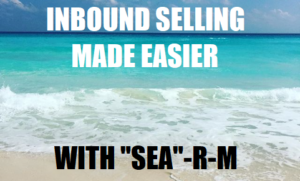The traditional benefit of a CRM system is still predominantly thought to be the outbound sales management functionality, but with the increasing prowess of marketing automation systems and, particularly their expanding integration into CRM platforms, how do the odds stack up for inbound rather than outbound sales within CRM?
In my last blog, I talked about the importance of a unified dataset for business improvement; and while the context is different in terms of the data being discussed, the same principle is absolutely relevant here. In order to stand the best chance of doing business with your leads and customers, you must understand them at every touch point. Even the lightest touches, such as repeat website visits and what products they are looking at, help you to connect and engage people as, well – people! So, to be clear, the value of having real business insights into customer behaviour in one place is key to the core principle of CRM – which is making every effort to understand the people and businesses you have a professional relationship with, how you can improve that relationship, and how you can provide more value to the customer.
Tracking the customer journey with CRM
Having said this, there’s much more to inbound selling than just website tracking history. It’s also important to see in that same one place how, why and when a customer contacted you, and what happened to them after that – how were they led through the customer journey. More specifically:
- The method they initially engaged with you – phone, email, web chat etc.
- Their reason for contacting you – did they simply want or need your product? Did they see one of your promotions? Were they referred to you by another customer etc.
- The date & time they first engaged with you – was it on a weekday or weekend? Time of day?
- What product or service they were initially interested in
- How you engaged with them after their enquiry – the steps you led them through
The value of collecting this information is proven when you use it to change the way you engage with customers to make it easier and more valuable for them to buy from you. As examples of where your strategy might be refined based on this information:
- You may choose to focus on staff responding to lead capture forms rather than be available on shop floors if you find that this is where most of your enquiries come from
- You may choose to have more staff on hand in the evening if you find that this is when most enquires come in, and you want to differentiate yourself from the competition on responsiveness
- You may choose to make the first step of the customer engagement process by scheduling a call with an expert if you find that most people do not purchase the product or service they initially enquired about
There are many ways to look at the information being captured and analysing it to turn it into actionable insights, but the first step must be to accurately capture the information that will ultimately influence the way you operate.
Using data to sell
So we’ve established the basic need and the value for recording inbound sales information. By capturing this customer data and keeping it in the same place as everything else you know about the customer, you can start to ask informed questions which can be used to drive changes or refinements. This change is not limited to your strategy – it could also be changes to the customer experience and perhaps even the products or services you offer, based on sales & engagement trends identified, along with information about the customer journey.
For example, if you identify that most of your customers who purchase Product A do so with little research, but customers who purchase product B typically visit your site multiple times and ask for discounts, you might use that to create a light touch email campaign along the lines of “we noticed you were looking at Product B, here’s some helpful information about this type of product and why you should consider us.” You might also glean that people who purchase Product B usually do so on finance, so you could also mention flexible finance options in your light touch email campaign. If your business model is more high-value, low-volume based, perhaps scheduling time for business development reps to call leads while they are on your website doing research could be an influencing factor in their decision making process. Or perhaps you will note that the majority of your customers actually don’t buy the product they initially enquire about, and try to streamline the way they receive advice from you.
CRM for inbound selling requires digital transformation
Hopefully you’ll have noticed a common theme so far in this article – the need for customer information to be stored in one place, or be so tightly knitted together that you can’t tell it isn’t. Why is this important? Because it’s key to running a successful CRM system, which in turn can help you run a successful business in a rapidly evolving environment. The pace at which the digital revolution is sweeping through businesses in many industries means that you can no longer afford to be the supplier who doesn’t know everything about a customer when they give you a call; or the supplier who doesn’t make it easy to talk to an expert; or the supplier who doesn’t help the customer get the most value from buying from them. What this really highlights is the greater need for digital transformation, which is the pillar that effective business data analysis stands atop. Without capturing as much information as you can about your customers’ interactions with you, you cannot hope to gain the knowledge that is essential to becoming leaders in your industry.
In summary
- CRM is the right place to have visibility of all customer information, including inbound sales data
- The value of capturing and tightly tying together customer data is proven when you use it to make changes to your sales & marketing strategy and refine the customer journey
- If you aren’t already on a digital journey and capturing valuable customer engagement information, the time to embark on that journey is now





